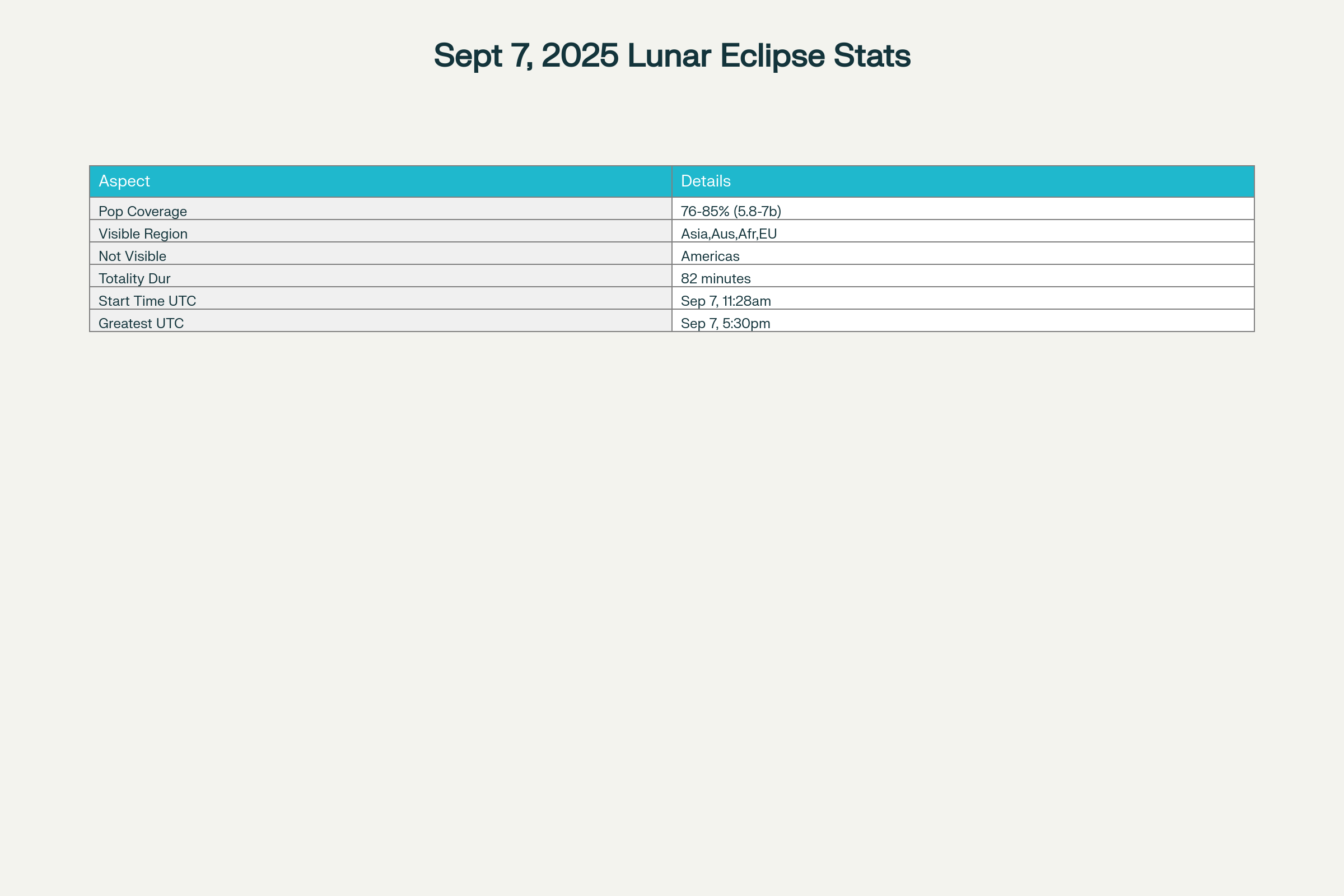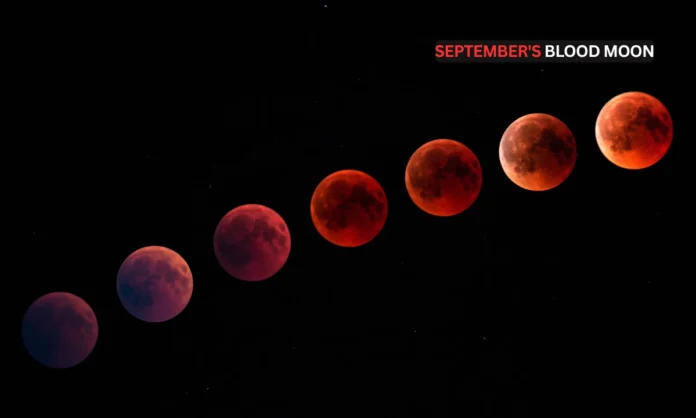Key Highlights
- Total lunar eclipse on September 7-8, 2025, creating a striking blood moon visible globally
- Around 76-85% of the world population, over 5.8 billion people, will witness the celestial event
- Expert tips on optimal viewing and astrophotography to capture the eclipse’s full glory
Opening Overview
The night sky is poised to deliver one of the most breathtaking celestial spectacles of the decade as the blood moon total lunar eclipse September 7 2025 prepares to captivate millions of stargazers worldwide. This extraordinary astronomical event will transform Earth’s natural satellite into a mesmerizing crimson orb, offering an unforgettable viewing experience for billions across multiple continents. With just days remaining before this rare phenomenon unfolds, astronomers and casual observers alike are preparing to witness what promises to be one of the most accessible and spectacular blood moon total lunar eclipse September 7 2025 events in recent memory.
Sky watchers are in for a treat next month, says Abigail Beall, when there is a total lunar eclipse visible in much of the world https://t.co/N0zAO5QmDu
— New Scientist (@newscientist) September 1, 2025
The approaching lunar eclipse stands out as particularly significant due to its extended duration and exceptional global visibility. Unlike many eclipses that favor specific geographic regions, this blood moon total lunar eclipse September 7 2025 will be observable across vast swaths of the planet, ensuring that the majority of humanity can participate in this shared cosmic moment.
The event’s remarkable 82-minute totality phase provides an extended opportunity for observation, photography, and scientific study, making it an ideal celestial event for both seasoned astronomers and first-time eclipse watchers. As Earth’s shadow prepares to envelop the Moon, creating the characteristic reddish glow that defines the blood moon total lunar eclipse September 7 2025, millions are already positioning themselves for optimal viewing locations to capture this once-in-a-lifetime experience.
The Science Behind the Blood Moon Total Lunar Eclipse
The fascinating mechanics underlying the blood moon total lunar eclipse September 7 2025 involve precise orbital alignments and atmospheric physics that transform a routine full moon into a captivating crimson spectacle. During this celestial event, Earth positions itself directly between the Sun and Moon, casting its shadow across the lunar surface and creating the conditions necessary for totality. The eclipse occurs when the Moon passes through Earth’s umbra, the darkest part of our planet’s shadow, resulting in the dramatic visual transformation that characterizes every blood moon total lunar eclipse September 7 2025.
The distinctive red coloration that gives the blood moon its name stems from a phenomenon known as Rayleigh scattering, the same process responsible for Earth’s blue skies and colorful sunsets. As sunlight passes through Earth’s atmosphere during the eclipse, shorter blue wavelengths are scattered away by atmospheric particles, while longer red wavelengths continue their journey toward the Moon’s surface. This filtered sunlight, now dominated by red and orange hues, illuminates the eclipsed Moon and creates the haunting blood moon total lunar eclipse September 7 2025 appearance that has fascinated humanity throughout history.
The specific parameters of this eclipse reveal its exceptional nature, with an umbral magnitude of 1.36379 indicating that the Moon will be deeply immersed within Earth’s shadow. The gamma value of −0.27521 demonstrates that the Moon will pass through the southern portion of Earth’s shadow, contributing to the eclipse’s extended duration and global visibility. These precise astronomical measurements confirm that the blood moon total lunar eclipse September 7 2025 will deliver optimal viewing conditions for observers positioned within the visibility zone, ensuring that the Moon’s transformation will be both dramatic and easily observable to the naked eye.
Where and When to Witness the Blood Moon Total Lunar Eclipse
The global accessibility of the blood moon total lunar eclipse September 7 2025 makes it one of the most inclusive astronomical events of the decade, with approximately 76-85% of the world’s population positioned to observe at least portions of the eclipse. This extraordinary visibility encompasses major population centers across Asia, Australia, Africa, and Eastern Europe, ensuring that over 5.8 billion people will have the opportunity to witness this celestial phenomenon. The eclipse’s timing favors regions where the Moon will be prominently positioned in the night sky during the critical totality phase.
The blood moon total lunar eclipse September 7 2025 begins its global progression at 11:28 a.m. UTC on September 7, with the crucial totality phase commencing at 1:30 p.m. ET (17:30 UTC). For observers in India, the eclipse will be visible from approximately 8:58 p.m. IST on September 7, reaching its peak around 11:00 p.m. IST, and concluding after midnight on September 8. Australian and New Zealand viewers will enjoy prime viewing conditions throughout the night, with the Moon positioned high in their evening sky during totality. Unfortunately, most of North and South America will experience daylight during the eclipse, rendering the blood moon total lunar eclipse September 7 2025 invisible from these regions.

Global Visibility and Timing of the September 7, 2025 Total Lunar Eclipse
The eclipse’s exceptional 82-minute totality duration provides an extended window for observation and photography, significantly longer than many previous lunar eclipses. This extended timeframe allows observers multiple opportunities to witness the Moon’s gradual transformation from its normal bright appearance to the characteristic deep red of totality, before slowly emerging from Earth’s shadow. European observers may catch glimpses of the eclipse’s later phases as the Moon rises in their evening sky, though they will miss the initial stages of the blood moon total lunar eclipse September 7 2025.
Astrophotography and Viewing Tips for the Blood Moon Total Lunar Eclipse
Capturing stunning images of the blood moon total lunar eclipse September 7 2025 requires careful preparation and appropriate equipment, though the event remains accessible to photographers of all skill levels. Professional astrophotographers recommend using cameras equipped with lenses of at least 400mm focal length on full-frame sensors to achieve detailed lunar disc images that showcase surface features during the eclipse. For optimal results during the blood moon total lunar eclipse September 7 2025, photographers should mount their cameras on sturdy tripods or, preferably, tracking mounts that compensate for Earth’s rotation and eliminate image blur during longer exposures.
Camera settings play a crucial role in successfully photographing the blood moon total lunar eclipse September 7 2025, with recommended ISO values ranging from 200-400 for the bright phases before and after totality. During totality, when the Moon appears significantly dimmer with its characteristic red glow, photographers will need to increase ISO settings or extend exposure times to capture the subtle colors and details of the eclipsed lunar surface. Using apertures around f/8 to f/11 provides the optimal balance between image sharpness and light-gathering capability, while regular interval shooting every few minutes documents the eclipse’s progression.
Naked-eye observers planning to witness the blood moon total lunar eclipse September 7 2025 should seek locations with clear eastern horizons and minimal light pollution for the best viewing experience. Unlike solar eclipses, lunar eclipses pose no danger to eyesight and can be safely observed directly without special filters or protective equipment. Binoculars enhance the viewing experience by revealing lunar surface details and color variations during totality, while telescopes provide even more detailed views of the Moon’s transformation. For those unable to observe directly due to weather conditions or geographic limitations, various online platforms will provide live streaming coverage of the blood moon total lunar eclipse September 7 2025, ensuring global access to this remarkable celestial event.
Final Perspective
The blood moon total lunar eclipse September 7 2025 represents far more than a simple astronomical occurrence, it embodies a moment of global unity as billions of people simultaneously gaze upward to witness the same cosmic spectacle. This rare convergence of perfect orbital mechanics and widespread visibility creates an opportunity for shared wonder that transcends geographic boundaries and cultural differences. As Earth’s shadow transforms the familiar bright Moon into a mysterious crimson orb, observers worldwide will participate in humanity’s oldest tradition of celestial observation and contemplation.
The event’s significance extends beyond its immediate visual impact, serving as a powerful reminder of our planet’s dynamic relationship with its celestial neighbors and the intricate cosmic dance that governs our solar system. For many, the blood moon total lunar eclipse September 7 2025 will mark their first direct encounter with a total lunar eclipse, potentially inspiring lifelong interests in astronomy and space science. The eclipse also provides valuable opportunities for scientific observation and data collection, contributing to our understanding of Earth’s atmospheric properties and their effects on celestial light.
As September 7 approaches, millions of eclipse enthusiasts are finalizing their viewing plans and preparing their equipment to document this extraordinary blood moon total lunar eclipse September 7 2025. Whether observed through sophisticated telescopes, captured with professional cameras, or simply appreciated with the naked eye, this celestial event promises to create lasting memories and inspire continued exploration of the night sky. The approaching eclipse serves as a perfect reminder that some of nature’s most spectacular displays remain freely accessible to all, requiring only clear skies and a willingness to look up at the precise moment when Earth, Moon, and Sun align in perfect cosmic harmony.


